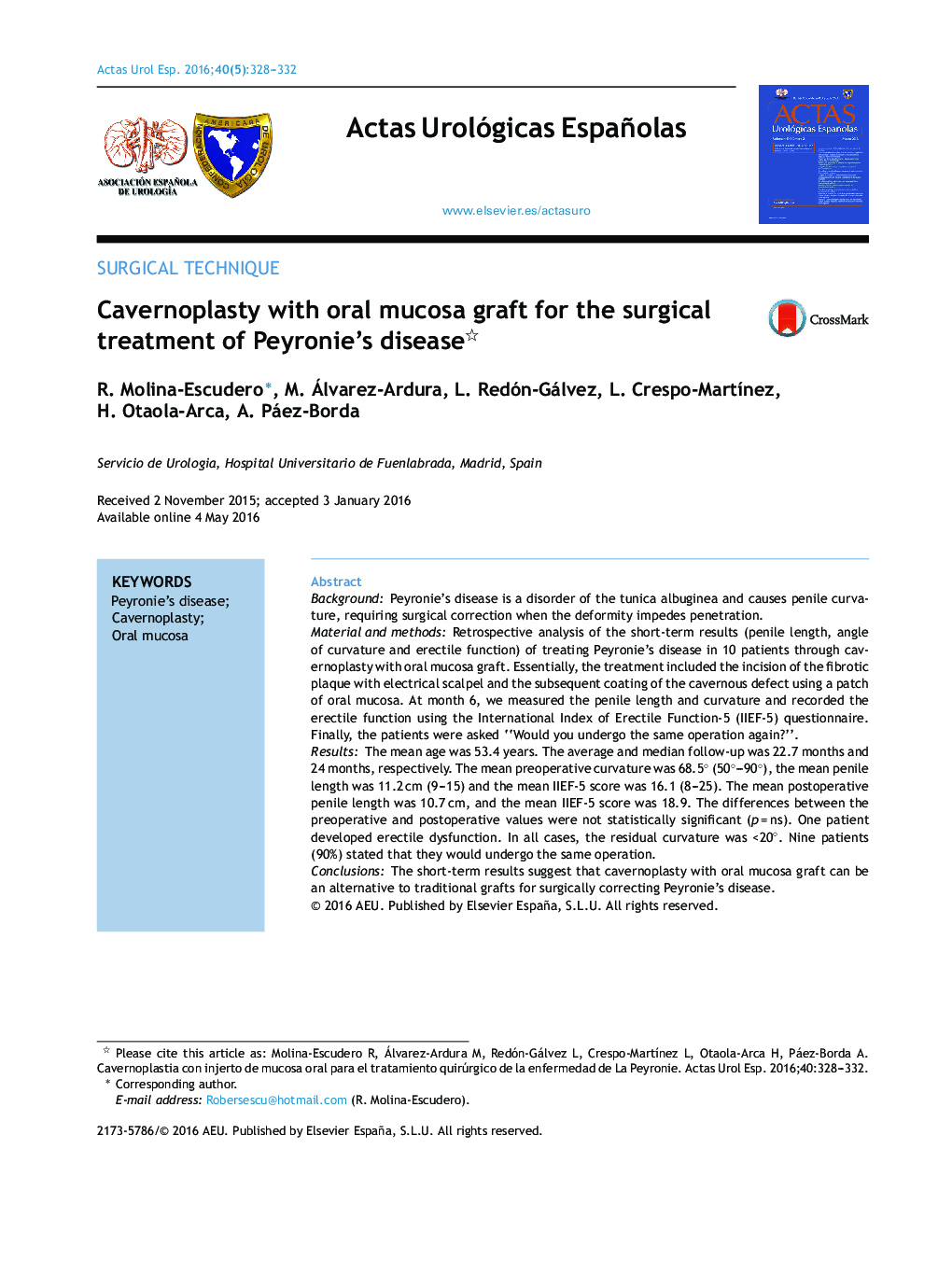| کد مقاله | کد نشریه | سال انتشار | مقاله انگلیسی | نسخه تمام متن |
|---|---|---|---|---|
| 3845141 | 1248243 | 2016 | 5 صفحه PDF | دانلود رایگان |
BackgroundPeyronie's disease is a disorder of the tunica albuginea and causes penile curvature, requiring surgical correction when the deformity impedes penetration.Material and methodsRetrospective analysis of the short-term results (penile length, angle of curvature and erectile function) of treating Peyronie's disease in 10 patients through cavernoplasty with oral mucosa graft. Essentially, the treatment included the incision of the fibrotic plaque with electrical scalpel and the subsequent coating of the cavernous defect using a patch of oral mucosa. At month 6, we measured the penile length and curvature and recorded the erectile function using the International Index of Erectile Function-5 (IIEF-5) questionnaire. Finally, the patients were asked “Would you undergo the same operation again?”.ResultsThe mean age was 53.4 years. The average and median follow-up was 22.7 months and 24 months, respectively. The mean preoperative curvature was 68.5° (50°–90°), the mean penile length was 11.2 cm (9–15) and the mean IIEF-5 score was 16.1 (8–25). The mean postoperative penile length was 10.7 cm, and the mean IIEF-5 score was 18.9. The differences between the preoperative and postoperative values were not statistically significant (p = ns). One patient developed erectile dysfunction. In all cases, the residual curvature was <20°. Nine patients (90%) stated that they would undergo the same operation.ConclusionsThe short-term results suggest that cavernoplasty with oral mucosa graft can be an alternative to traditional grafts for surgically correcting Peyronie's disease.
ResumenIntroducciónLa enfermedad de La Peyronie es un trastorno de la albugínea que condiciona incurvación peneana, y que precisa corrección quirúrgica cuando la deformidad dificulta la penetración.Material y métodosAnálisis retrospectivo de los resultados a corto plazo (longitud del pene, ángulo de incurvación y función eréctil) del tratamiento de la enfermedad de La Peyronie en 10 pacientes mediante cavernoplastia con injerto de mucosa oral. En esencia, el tratamiento incluyó la incisión de la placa fibrótica con bisturí eléctrico y el posterior recubrimiento del defecto cavernoso mediante un parche de mucosa oral. Al sexto mes medimos la longitud e incurvación peneanas, y recogimos la función eréctil mediante el cuestionario IIEF-5. Finalmente, se planteó a los pacientes la pregunta «¿volvería a repetir la misma intervención?».ResultadosLa edad media fue de 53,4 años. El seguimiento promedio fue de 22,7 meses y la mediana de 24. La incurvación media preoperatoria fue de 68,5° (50-90°); la longitud media del pene de 11,2 cm (9-15) y el IIEF-5 medio de 16,1 (8-25). La longitud peneana media postoperatoria fue de 10,7 cm y el IIEF-5 medio de 18,9. Las diferencias entre los registros pre- y postoperatorios no alcanzaron significación estadística (p = ns). Un paciente desarrolló disfunción eréctil. En todos los casos la incurvación residual fue < 20°. Nueve pacientes (90%) aseguraron que repetirían la misma intervención.ConclusionesLos resultados a corto plazo señalan que la cavernoplastia con injerto de mucosa oral puede ser una alternativa a los injertos tradicionales para la corrección quirúrgica de la enfermedad de La Peyronie.
Journal: Actas Urológicas Españolas (English Edition) - Volume 40, Issue 5, June 2016, Pages 328–332
